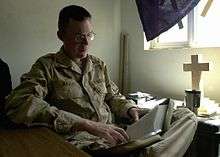Chaplain

| Part of a series on the |
| Hierarchy of the Catholic Church |
|---|
 |
| Ecclesiastical titles (order of precedence) |
|
|
Liturgical titles |
|
Administrative and pastoral titles
|
|
Consecrated and professed titles |
|
Organization titles |
|
|
A chaplain is a cleric (such as a minister, priest, pastor, rabbi, or imam), or a lay representative of a religious tradition, attached to a secular institution such as a hospital, prison, military unit, school, business, police department, fire department, university, or private chapel.
Though originally the word "chaplain" referred to representatives of the Christian faith,[1][2] it is now also applied to people of other religions or philosophical traditions–such as the case of chaplains serving with military forces and an increasing number of chaplaincies at American universities.[3] In recent times, many lay people have received professional training in chaplaincy and are now appointed as chaplains in schools, hospitals, companies, universities, prisons and elsewhere to work alongside, or instead of, official members of the clergy.[4] The concepts of "multifaith", "secular", "generic" and/or "humanist" chaplaincy are also gaining increasing support, particularly within healthcare and educational settings.[5]
Types of chaplaincies
Education
School chaplains are a fixture in religious and, more recently, secular schools. In religious schools the role of the chaplain tends to be educational and liturgical. In secular schools the role of the chaplain tends to be that of a mentor and a provider of pastoral care services. Chaplains provide care for students by supporting them during times of crisis or need. Many chaplains run programs to promote the welfare of students, staff and parents including programs to help students deal with grief, anger or depression. Chaplains also build relationships with students by participating in extracurricular activities such as breakfast programs, lunchtime groups and sports groups. School chaplains can also liaise with external organisations providing support services for the school.[6] With stagnant incomes and rising prices putting pressure on independent school budgets, cutting the post of school chaplain can seem an "easy" saving. Many schools now have pupil support departments with several mentors whose jobs are to look out for the pupils and always be there to help but they give no religious or spiritual guidance because of multiculturalism and diverse opinions on religion and beliefs.
In Australia chaplains in state schools have, controversially,[7] been funded by the federal government and local communities since 2007. Australian chaplains assist school communities to support the spiritual, social, and emotional well-being of their students.[8] Chaplaincy services are provided by non denominational companies. As of August 2013 there are 2339 chaplains working in Australian secular schools, along with 512 student welfare workers.[9] Australian Schools will lose the option of appointing secular social workers under the national school chaplaincy program, for which the Abbott government has found an extra $245m in the 2014 budget funding.[10]
Similarly, in Scotland the focus of school chaplaincy is on welfare and building positive relationships joining students on excursions and sharing meals. Chaplains are also non-denominational and act as a link between the school community and society. Like Australian chaplains it is expected that they will not proselytise.[11] In Ireland chaplaincy takes a very different approach in which chaplains are expected to teach up to four hours of class instruction per week and are usually Catholic. Chaplaincy duties include visiting homes, religious services, retreats and celebrations, as well as counselling.[12]
For higher education, chaplains are appointed by many colleges and universities, sometimes working directly for the institution, and sometimes as representatives of separate organizations that specifically work to support students, such as Hillel International for Jews or the Newman Centers for Catholics. In the United States, the National Association of College and University Chaplains works to support the efforts of many of these chaplains, helping chaplains minister to the individual faith of students, faculty, and staff, while promoting inter-religious understanding.[13] Chaplains often also oversee programs on campus that foster spiritual, ethical, religious, and political and cultural exchange, and the promotion of service. Each day communities respond to numerous disasters or emergencies. Most often, these incidents are managed effectively at the local level. However, there are some incidents that may require a collaborative approach that includes personnel from: 1. Multiple jurisdictions, 2. A combination of specialties or disciplines, 3. Several levels of government, 4. Non-governmental organizations, and 5. The private sector. Chaplain Fellowship Disaster Response certifies first responder chaplain for crisis and disaster response.
Fire departments
Chaplains working with fire departments provide the same kind of support as do chaplains working with law enforcement, and sometimes face even greater danger, working with the wounded in often very dangerous surroundings.
At the scene of the September 11 attacks on the World Trade Center in New York City, for example, New York City Fire Department Chaplain Fr. Mychal F. Judge was killed by flying debris from the South Tower when he re-entered the lobby of the North Tower of the World Trade Center, shortly after administering last rites to a wounded firefighter.[14]
Environmental
Environmental chaplaincy is an emerging field within chaplaincy. Environmental chaplains (also known as eco-chaplains, Earth chaplains, nature chaplains) provide spiritual care in a way that honors humanity's deep connection to the earth. Environmental chaplains hold many roles. They may support people working on the frontlines of issues like climate change or other environmental issues or they may support people impacted by industrial or other disasters by providing pastoral care, presence, and rituals. Environmental chaplains may also bear witness to the Earth itself and represent the merging of science and spirituality. Their role can be to "usher in a new conscience and consciousness to find contentment, the appreciation of inner riches over outer wealth, quality over quantity" using universally appreciated values, such as honesty and vision.[15] Sarah Vekasi [16] created a vision of eco-chaplaincy inspired by Joanna Macy's The Work that Reconnects,[17] and saw eco-chaplaincy as a path to facilitating the "Great Turning," which is described as the turning away from a business-as-usual way of being and turning toward a life-sustaining way that protects people and the planet [18]
Health care
Many hospitals, nursing homes, assisted living facilities, and hospices employ chaplains to assist with the spiritual, religious, and emotional needs of patients, families and staff. Chaplains are often employed at residential care facilities for the elderly (RCFE) and skilled nursing facilities (SNF) as well. Chaplains care for people of all faiths. In mental health work, chaplains are highly skilled at working with other therapists as part of a multi-disciplinary team, especially where the patient's mental ill-health is associated with their religiosity, or where their mental well-being can be aided by spiritual care.
In the United States, health care chaplains who are board-certified have completed a minimum of four units of Clinical Pastoral Education training through The American Association of Pastoral Counselors,[19] Association for Clinical Pastoral Education,[20] Healthcare Chaplains Ministry Association,[21] The Institute for Clinical Pastoral Training,;[22] or The College of Pastoral Supervision and Psychotherapy[23] and may be certified by one of the following organizations: The American Association of Pastoral Counselors,[19] The Association of Professional Chaplains,[24] The National Association of Catholic Chaplains,[25] Neshama: Association of Jewish Chaplains (formerly The National Association of Jewish Chaplains),[26] The Association of Certified Christian Chaplains,[22] or The College of Pastoral Supervision and Psychotherapy.[23] Certification typically requires a Masters of Divinity degree (or its equivalent), faith group ordination or commissioning, faith group endorsement, and four units (1600 hours) of Clinical Pastoral Education (the Military Chaplains Association of the United States of America does require more, but they are a dod2088 501c-3 military support group founded in 1954 by Military Chaplains).[27]
In Canada, health care chaplains may be certified by the Canadian Association for Spiritual Care.
In the UK, health care chaplains are employed by their local NHS Trust (Health Boards in Scotland and Wales) or by charities associated with hospice. The NHS in England publishes guidance on good practice in chaplaincy care.[28] Many work part-time, combining their role with another post, either in a local faith community or another chaplaincy, and some are honorary (unpaid). The professional body in England and Wales is the College of Health Care Chaplains.[29] In Scotland and Northern Ireland, the bodies are the Scottish Association of Chaplains in Healthcare (SACH) and the Northern Ireland Healthcare Chaplains Association. Membership of the College of Health Care Chaplains is not compulsory but may be advantageous as it carries with it membership of a Trade Union. Chaplains working in a palliative care setting may also choose to join the Association of Hospice and Palliative Care Chaplains.[30]
Within the UK there is also the UK Board of Healthcare Chaplaincy[31] (UKBHC) which has been set up in order to regulate the ministry and professional practice of health care chaplains. They publish a code of conduct which all registered chaplains are bound to abide by. The UKBHC is applying to the Professional Standards Authority[32] to be an accredited register of healthcare chaplains to demonstrate it meets the Authority's high standards in areas such as governance and training.
Peer-reviewed journals that publish scholarly articles and research on healthcare chaplaincy include the Journal of Health Care Chaplaincy,[33] and Health and Social Care Chaplaincy.[34]
Law enforcement
Law enforcement chaplains work with local, county, state, and federal law enforcement and provide a variety of services within the law enforcement community. They should not be confused with prison chaplains, whose primary ministry is to those who are incarcerated either awaiting trial or after conviction. The role of the law enforcement chaplain deals primarily with law enforcement personnel and agencies. The chaplain responds to these unique needs and challenges with religious guidance, reassuring and trustworthy presence, resources and counseling services. The law enforcement chaplain offers support to law enforcement officers, administrators, support staff, victims and their families, and occasionally even the families of accused or convicted offenders. Law enforcement chaplaincy is a ministry of presence and must have the proper training if they are working with law enforcement officers. Some ministries such as Chaplain Fellowship Ministries requires LEO chaplains to be certified in Public Safety Chaplaincy before becoming certified as a LEO chaplain.
Military
Military chaplains provide pastoral, spiritual and emotional support for service personnel, including the conduct of religious services at sea, on bases or in the field. Military chaplains have a long history; the first English military-oriented chaplains, for instance, were priests on board proto-naval vessels during the 8th century. Land-based chaplains appeared during the reign of King Edward I. The current form of military chaplain dates from the era of the First World War.
Chaplains are nominated, appointed, or commissioned in different ways in different countries. A military chaplain can be an army-trained soldier with additional theological training or an ordained person nominated to the army by religious authorities. In the United Kingdom the Ministry of Defence employs chaplains but their authority comes from their sending church. Royal Navy chaplains undertake a 16-week bespoke induction and training course including a short course at Britannia Royal Naval College and specialist fleet time at sea alongside a more experienced chaplain. Naval chaplains called to service with the Royal Marines undertake a grueling five-month-long Commando Course and, if successful, wear the commandos' Green Beret. British Army chaplains undertake seven weeks training at the Armed Forces Chaplaincy Centre Amport House and the Royal Military Academy Sandhurst. Royal Air Force chaplains must complete a 12-week Specialist Entrant course at the RAF College Cranwell followed by the Chaplains' Induction Course at the Armed Forces Chaplaincy Centre Amport House of a further two weeks. The United States Navy will often give chaplain training to cadets seeking a theological route in the military.[35] Additionally, they are granted instant employment as a Navy chaplain once ordained.[36] Additionally, in the United States military, chaplains must be endorsed by their religious affiliation in order to serve in any facet of the military.[37][38] In some cases, like that of the U.S. Navy, a Religious Program Specialist may be appointed to help alleviate some of the duties bestowed upon Naval chaplains.[39]

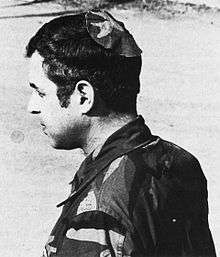
Military chaplains are normally accorded officer status, although Sierra Leone had a Naval Lance Corporal chaplain in 2001. In most navies, their badges and insignia do not differentiate their levels of responsibility and status. By contrast, in air forces and armies, they typically carry ranks and are differentiated by crosses or other equivalent religious insignia. However, United States military chaplains in every branch carry both rank and Chaplain Corps insignia.
Though the Geneva Conventions does not state whether chaplains may bear arms, they specify (Protocol I, June 8, 1977, Art 43.2) that chaplains are non-combatants. In recent times both the UK and US have required chaplains, but not medical personnel, to be unarmed. Other nations, notably Norway, Denmark and Sweden, make it an issue of individual conscience. Captured chaplains are not considered Prisoners of War (Third Convention, August 12, 1949, Chapter IV Art 33) and must be returned to their home nation unless retained to minister to prisoners of war.
Inevitably, a significant number of serving chaplains have died in action. 100 chaplains of the U.S. Army and the U.S. Marine Corps were killed in action during World War II: a casualty rate greater "than any other branch of the services except the infantry and the Army Air Corps" (Crosby, 1994, pxxiii). Many have been decorated for bravery in action (five have won Britain's highest award for gallantry, the Victoria Cross). The Chaplain's Medal for Heroism is a special U.S. military decoration given to military chaplains who have been killed in the line of duty, although it has to date only been awarded to the famous Four Chaplains, all of whom died in the Dorchester sinking in 1943 after giving up their lifejackets to others. In addition to these, five other U.S. chaplains have been awarded the Medal of Honor: Chaplain (LCDR) Joseph T. O'Callahan, USN (World War II); Chaplain (CPT) Emil Kapaun, USA (Posthumous, Korean War); Chaplain (LT) Vincent Capodanno, USN (Posthumous, Vietnam War); Chaplain (MAJ) Charles J. Watters, USA (Posthumous, Vietnam War); and Chaplain (CPT) Angelo J. Liteky, USA (Vietnam). (Later in life, Liteky changed his name to Charles, left the Catholic priesthood, became an anti-war activist, and renounced his Medal of Honor). Chaplain Fellowship Ministries military chaplains are nondenominational. To be considered for appointment to serve as a military chaplain, candidates must first be ordained and have an ecclesiastical endorsement by a valid religious faith group recognized by the Department of Defense. Candidates must meet all DOD requirements. The Chaplain Fellowship had military chaplains serving in Iraq and now in Afghanistan.
In 2006, training materials obtained by U.S. intelligence showed that insurgent snipers fighting in Iraq were urged to single out and attack engineers, medics, and chaplains on the theory that those casualties would demoralize entire enemy units.[40]
The United States European Command has co-sponsored an annual International Military Chiefs of Chaplains Conference every year since 1991.
At times, the existence of military chaplains has been challenged in countries that have a separation of Church and State.[41][42]
Music
Some chaplains use live music as a therapeutic tool.[43] Music can aid in healing, access core faith and emotions, and help to build rapport in the chaplaincy relationship.[44]
Musical bands (especially Christian groups) may bring a chaplain with them to conduct services while they are on tour. There can also be chaplains who minister to concert-goers at music festivals.
Muslim chaplains do not use music, as it is forbidden.
Parliamentary

Some nations, including the United States and the United Kingdom, have chaplains appointed to work with parliamentary bodies, such as the Chaplain of the United States Senate, the Chaplain of the United States House of Representatives, and Chaplain to the Speaker of the House of Commons.[45] In addition to opening proceedings with prayer, these chaplains provide pastoral counseling to congressional members, their staffs, and their families; coordinate the scheduling of guest chaplains, who offer opening prayers; arrange and sometimes conduct marriages, memorial services, and funeral services for congress, staff, and their families; and conduct or coordinate religious services, study groups, prayer meetings, holiday programs, and religious education programs, as well.
Prison
Prison chaplains can be a "safety valve, through listening and pro-social intervention" in potentially explosive situations.[46] They also reduce recidivism by linking offenders to positive community resources, and in the work they do to help offenders change their hearts, minds and directions.[46]
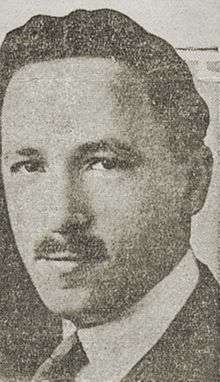
Rabbi Philip R. Alstat (1891–1976), who—in addition to work as a chaplain in New York hospitals and senior citizen facilities—served for three decades as the Jewish chaplain for "The Tombs", the Manhattan Detention Facility, once described his service as follows: "My goals are the same as those of the prison authorities—to make better human beings. The only difference is that their means are discipline, security, and iron bars. Mine are the spiritual ministrations that operate with the mind and the heart."[47]
In Canada in 2013, a $2 million contract for chaplaincy services for federal prisons was awarded to Kairos Pneuma Chaplaincy Inc., a company newly formed by five current and former federal prison chaplains.[48][49] About "2,500 volunteers, many of them of minority faiths, would also continue providing services."[50]
Sports
A sports chaplain provides pastoral care for the sports person and the broader sports community including the coach, administrators and their families.
Chaplains to sports communities have existed since the middle of the 20th century and have significantly grown in the past 20 years. The United States, United Kingdom and Australia have well established Christian sports chaplaincy ministries.
Sports chaplains consist of people from many different walks of life. Most commonly, the chaplains are ministers or full-time Christian workers but occasionally, chaplaincy work is done without charge or any financial remuneration. Often, sports chaplains to a particular sport are former participants of that sport. This helps the chaplain to not only provide spiritual support and guidance to a player, but also to give them the ability to empathize and relate to some of the challenges facing the participant with whom they are ministering.
Animal
Veterinary chaplains serve people and their animals, ministering with regards to the spirituality associated with animals and their connections with humans.[51] A major function is grief support and prayer.[52] Other services include hospice support while animals are cared for near the end of their lives; support in animal health crises, including at the veterinary hospital; conducting services for animal blessings, naming/adopting ceremonies, and end of life celebration ceremonies.[51] Veterinary chaplains may also offer sermons and spiritual guidance on the human/animal bond and our responsibilities toward animals; and some may visit nursing homes and hospitals with therapeutic animal assistants.[53] Other veterinary chaplains may provide blessings for animal care workers; assist with human/animal communication; and offer alternative healing for animals such as animal Reiki or acupuncture. Reiki.[54]
The Emerson Theological Institute, headquartered in Oakhurst, California, and working within the New Thought spiritual approach, offers degree programs up to the doctorate level in Humane Religious Studies, the cornerstone of which is a veterinary chaplain program.[55] The Animal Ministry Institute (AMI), run by the Rev. Paula T. Webb, also offers an online chaplain program for continuing education but without college credit.[56] A less formal online certificate program is offered by the Rev. Karen j Kobrin Cohen, a veterinary chaplain based in Florida.[57]
Colonial
A colonial chaplain was appointed to a colony. The term is commonly used to refer to the chaplain appointed as a non-military chaplain to one of the Crown Colonies from the late 18th century or early 19th century. Richard Johnson (1756–1827) was the first colonial chaplain appointed to the new prison colony at New South Wales in 1786.
Corporate
Some businesses, large or small, employ chaplains for their staff and/or clientele. Services provided may include employee assistance and counseling services; wellness seminars; conflict management and mediation; leadership and management development; and trauma/serious incident response.[58] In 2007, 4,000 corporate chaplains were reported to be working in the U.S.,[59] with the majority being employees of specialist chaplaincy companies such as Marketplace Chaplains USA[60] and Corporate Chaplains of America.[61] In 2014, Marketplace Chaplains USA reported employing over 2,800 chaplains in 44 states and over 960 cities.[62] The organization added an international arm in 2006; Marketplace Chaplains International serves Canada, the U.K., Mexico and Puerto Rico.[63] Capellania Empresarial[64] provides corporate chaplaincy services in Paraguay. Chaplains without Borders[65] has been providing corporate and other chaplaincy services in Australia since 2005.
Cruise
Working on board cruise ships, cruise chaplains play a vital role in providing pastoral and spiritual support to both passengers and crew members. With the co-operation of cruise companies, chaplains normally stay on board for the specific duration of a cruise. Catholic seafarers' charity Apostleship of the Sea[66] currently deploys chaplains on board P&O Cruises[67] and Cunard Line[68] ships during the Christmas and Easter periods. While ministering to passengers are part of Apostleship of the Sea's chaplains[69] role, their main focus is the welfare of the crew, who can often spend many months at sea away from home.
Domestic
A domestic chaplain was a chaplain attached to a noble household in order to grant the family a degree of self-sufficiency in religion. The chaplain was freed from any obligation to reside in a particular place so could travel with the family, internationally if necessary, and minister to their spiritual needs. Further, the family could appoint a chaplain who reflected their own doctrinal views. Domestic chaplains performed family christenings, funerals and weddings and were able to conduct services in the family's private chapel, excusing the nobility from attending public worship.[70]
In feudal times most laymen, and for centuries even most noblemen, were poorly educated and the chaplain would also be an important source of scholarship in the household, tutoring children and providing counsel to the family on matters broader than religion.[70] Before the advent of the legal profession, modern bureaucracy and civil service, the literate clergy were often employed as secretarial staff, as in a chancery. Hence the term clerk, derived from Latin clericus (clergyman). This made them very influential in temporal affairs. There was also a moral impact since they heard the confessions of the elite.
The domestic chaplain was an important part of the life of the peerage in England from the reign of Henry VIII to the middle of the 19th century. Up until 1840, Anglican domestic chaplains were regulated by law and enjoyed the substantial financial advantage of being able to purchase a license to hold two benefices simultaneously while residing in neither.[70]
Many monarchies and major noble houses had, or still have, several domestic or private chaplains as part of their Ecclesiastical Household, either following them or attached to a castle or other residence. Queen Elizabeth II has 36 Anglican chaplains, in addition to chaplains extraordinary and honorary chaplains appointed to minister to her. Castles with attached chaplains generally had at least one Chapel Royal, sometimes as significant as a cathedral. A modern example is St George's Chapel, Windsor Castle, also the home of the Order of the Garter.
Other
There are also chaplains to private clubs, television or radio stations, family, community teams, groups such as Boys and Girls Brigade companies and Scout troops, airports, cruise ships, nightclubs, and theaters.
The term can also refer to priests attached to Roman Catholic convents. There is also the position of Chaplain of His Holiness, a title granted by the Pope to certain priests who become part of the Papal Household and work with the Papal Chapel. Prior to 1968 they were called Supernumerary Privy Chamberlains.
In popular culture
Father Francis Duffy, famed chaplain of the U.S. 69th Infantry Regiment in World War I, was a central character portrayed by Pat O'Brien in the 1940 Warner Brothers movie The Fighting 69th.
Father Barry was a waterfront priest played by Karl Malden, who was shamed into fomenting violence against the union/mob in the classic movie On the Waterfront, directed by Elia Kazan and starring Marlon Brando, Rod Steiger, and Eva Marie Saint.
Chaplains have appeared as characters in several works of fiction about historical and imagined militaries. Father Mulcahy, a character in the M*A*S*H novels, film, and TV series, is a well known fictional chaplain.
In addition, chaplains have been featured in mass media channels, such as the popular comic strip Doonesbury, authored by Pulitzer Prize–winning author Garry Trudeau. The Rev. Scot Sloan is a character in Doonesbury inspired by real people: Stanford's Dean for Religious Life, Scotty McLennan, along with his mentor, former Yale chaplain William Sloane Coffin.
The chaplain is also a key figure in Albert Camus' novel L'Etranger ("The Stranger", sometimes called The Outsider).
The profession of military chaplaincy is reflected in several major works of world literature, such as in the Herman Melville novella Billy Budd, Jaroslav Hasek's novel The Good Soldier Švejk, and Joseph Heller's novel Catch-22.
Jewish chaplains have been featured as main characters in books such as Herbert Tarr's The Conversion of Chaplain Cohen (which also includes an excellent portrayal of the U.S. Air Force Chaplain School experience), and Chaim Potok's The Book of Lights.
In the dystopian science fiction setting of Warhammer 40,000, chaplains are Space Marine warrior priests. They are typically the most pious and zealous warriors in a Space Marine chapter and always fight at the forefront of an engagement.
Chaplains serve as combat soldiers in the Mobile Infantry from Robert A. Heinlein's Starship Troopers.
The life of Dr. Lonnie Pepper, a fictional corporate chaplain, is detailed in a novel written by Mark Cress called The Third Awakening.
In the television series V, one of the main characters, Father Jack, is mentioned as having served as a military chaplain before the series.
- Gallery
 Samuel Provoost, First Chaplain of the Continental Congress, 1789
Samuel Provoost, First Chaplain of the Continental Congress, 1789 Maryland, Germantown. Headquarters Christian Commission in the Field, 1863
Maryland, Germantown. Headquarters Christian Commission in the Field, 1863 Military Field Rabbi Dr. Aaron Tänzer during World War I, with the ribbon of the Iron Cross.[71] The brassard of the red cross shows him as noncombatant. He wears the star of david as insignium
Military Field Rabbi Dr. Aaron Tänzer during World War I, with the ribbon of the Iron Cross.[71] The brassard of the red cross shows him as noncombatant. He wears the star of david as insignium Rabbi Ralph Kreger, BCC with a patient's family member at Lenox Hill Hospital (part of the North Shore LIJ health system)
Rabbi Ralph Kreger, BCC with a patient's family member at Lenox Hill Hospital (part of the North Shore LIJ health system) Monument to Chaplain Father Francis Duffy in Times Square (click for obverse text)
Monument to Chaplain Father Francis Duffy in Times Square (click for obverse text) 'Four Chaplains' stained glass window, U.S. Pentagon
'Four Chaplains' stained glass window, U.S. Pentagon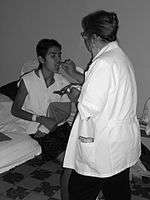 A hospitalized man receives communion from a chaplain, Guadalajara, Mexico
A hospitalized man receives communion from a chaplain, Guadalajara, Mexico President George W. Bush congratulates Navy Chaplain, Imam Abuhena Saifulislam, the first U.S. Navy Muslim chaplain assigned to the Marine Corps
President George W. Bush congratulates Navy Chaplain, Imam Abuhena Saifulislam, the first U.S. Navy Muslim chaplain assigned to the Marine Corps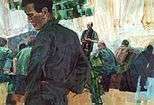 Religious Services 1st Cav AKA Thy Rod and Thy Staff, They Comfort Me by Paul Rickert, U. S. Army Vietnam Combat Artists Program, Team IX (CAT I 1966). Courtesy National Museum of the U. S. Army.
Religious Services 1st Cav AKA Thy Rod and Thy Staff, They Comfort Me by Paul Rickert, U. S. Army Vietnam Combat Artists Program, Team IX (CAT I 1966). Courtesy National Museum of the U. S. Army.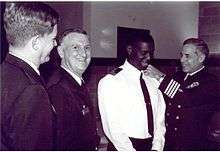 Frocking ceremony for U.S. Navy's first Muslim chaplain, when Navy (rabbi) Chaplain Arnold Resnicoff attaches new shoulder boards with Muslim Chaplain crescent insignia to uniform of Imam Monje Malak Abd al-Muta Noel Jr, 1996.
Frocking ceremony for U.S. Navy's first Muslim chaplain, when Navy (rabbi) Chaplain Arnold Resnicoff attaches new shoulder boards with Muslim Chaplain crescent insignia to uniform of Imam Monje Malak Abd al-Muta Noel Jr, 1996. An American chaplain in September 2001.
An American chaplain in September 2001.
See also
- Minister
- Priest
- Religion in United States prisons
- Ukraine prison ministry
- United States military chaplain symbols
References
- ↑ "Archived copy". Archived from the original on September 5, 2008. Retrieved September 9, 2010.
- ↑ Legood, Giles (1999). Chaplaincy: the church's sector ministries. London: Cassell. ISBN 0304702951.
- ↑ "Humanist Chaplaincies".
- ↑ Norman, J. (2004). At The Heart of Education: School Chaplaincy and Pastoral Care. Dublin: Veritas.
- ↑ Hewson, Chris (March 1, 2012). "Multifaith Spaces: Management". University of Manchester. Retrieved September 14, 2012.
- ↑ "What are school chaplains". Tuggerah Lakes Chaplains. Archived from the original on January 25, 2014. Retrieved July 19, 2014.
- ↑ "Revised school chaplaincy funding arrangements labelled 'arrogant and disgraceful' by High Court challenger". ABC News.
- ↑ "About Chaplaincy". Sydney: Genr8 Ministries. Retrieved July 19, 2014.
- ↑ "National School Chaplaincy and Student Welfare Program Statistics". Australian Government Department of Education. September 27, 2013. Retrieved July 19, 2014.
- ↑ Hurst, Daniel (May 14, 2014). "It will be chaplains, not secular social workers, at schools". The Guardian. Retrieved July 19, 2014.
- ↑ "The Role of the School Chaplain" (PDF). The Church of Scotland. Nov 13, 2012. Retrieved July 19, 2014.
- ↑ "The School Chaplain". School Chaplains' Association of Ireland. Retrieved July 19, 2014.
- ↑ "NACUC Mission". The National Association of College and University Chaplains. Archived from the original on July 24, 2014. Retrieved July 19, 2014.
- ↑ "Killed on 9/11, Fire Chaplain Becomes Larger Than Life". September 27, 2002.
- ↑ "Chaplaincy Program Graduates" (PDF). Upaya Zen Center. Retrieved August 20, 2015.
- ↑ "The Work that Reconnects". the Eco-Chaplaincy Initiative. Retrieved August 20, 2015.
- ↑ "The Work that Reconnects". The Work that Reconnects. Retrieved August 20, 2015.
- ↑ "The Great Turning". The Work that Reconnects. Retrieved August 20, 2015.
- 1 2 "American Association of Pastoral Counselors - Home".
- ↑ Inc., Advanced Solutions International,. "Home". www.acpe.edu.
- ↑ "Home".
- 1 2 "Association of Certified Christian Chaplains - Home". www.certifiedchaplains.org.
- 1 2 "CPSP Pastoral Report".
- ↑ "Association of Professional Chaplains". www.professionalchaplains.org.
- ↑ "Main Page".
- ↑ "Our Mission".
- ↑ "Website Disabled".
- ↑ "NHS Chaplaincy Guidelines 2015" (PDF). NHS England.
- ↑ "Home - College of Health Care Chaplains". College of Health Care Chaplains.
- ↑ "AHPCC". www.ahpcc.org.uk.
- ↑ "Welcome to the website of the UK Board of Healthcare Chaplaincy - UKBHC". www.ukbhc.org.uk.
- ↑ "Professional Standards Authority - Home". www.professionalstandards.org.uk.
- ↑ "Journal of Health Care Chaplaincy: Vol 23, No 3". www.tandfonline.com.
- ↑ "Health and Social Care Chaplaincy - Equinox Publishing".
- ↑ "Chaplain Training" (PDF).
- ↑ "Chaplain Jobs".
- ↑ "Requirements". goarmy.com.
- ↑ "Archived copy". Archived from the original on November 13, 2011. Retrieved July 27, 2011.
- ↑ "Religious Program Specialist".
- ↑ Ponder, Jon (25 October 2006). "Iraqi Insurgent Snipers Target U.S. Medics, Engineers and Chaplains". Pensito Review. Retrieved 21 March 2008.
- ↑ http://video.google.com/videoplay?docid=891776135764757633
- ↑ "Archived copy". Archived from the original on September 25, 2005. Retrieved 2008-04-15.
- ↑ "Singing chaplain uses music to comfort ailing patients - Pacific School of Religion". Archived from the original on December 18, 2014.
- ↑ Jesse Paledofsky; et al. "Song of the Soul: The Use of Live Music in Professional Chaplaincy" (PDf). Chaplaincy Today, vol. 28, no. 2, Autumn/Winter 2012, pp. 31–36.
- ↑ "Speaker's chaplain". UK Parliament.
- 1 2 Vance L. Drum (August 13, 2007). "Professional Correctional Chaplains: Fact and Fiction" (PDF). p. 11.
- ↑ Edward Fiske, New York Times, City Prison Chaplains' Load is Heavy, October 26, 1970.
- ↑ Tobi Cohen, Postmedia News (November 11, 2013). "Federal government awards $2-million contract for prison religious counselling to private company". National Post.
- ↑ Lloyd Bruce. "Sabbath Road".
- ↑ Cohen 2013.
- 1 2 "Animal chaplains teach that animals have spiritual nature". Ahwatukee Foothills News.
- ↑ "Services " Michigan Animal Chaplain".
- ↑ Animal Chaplain. "Welcome to AnimalChaplains.com blog!".
- ↑ "Article About Reverend Nancy Schluntz, Animal Chaplain".
- ↑ "Emerson Theological Institute - Animal Chaplain Credential - Emerson Theological Institute".
- ↑ "Animal Chaplain & Animal Ministry programs".
- ↑ "Certification Training". animalchaplain.
- ↑ "About Us". Archived from the original on October 22, 2014.
- ↑ The Economist (August 25, 2007, p 64).
- ↑ "Workplace Chaplains Counseling Employee Wellness Program Corporate Chaplain".
- ↑ "Corporate Chaplains of America - A nationwide network of full-time, trained chaplains bringing caring to the workplace.".
- ↑ "Corporate Chaplaincy Service Employee Wellness Program : Marketplace Chaplains".
- ↑ "Archived copy". Archived from the original on July 25, 2014. Retrieved 2014-07-19.
- ↑ "Archived copy". Archived from the original on January 30, 2010. Retrieved 2009-12-21.
- ↑ "Chaplains Without Borders".
- ↑ "Apostleship of the Sea Welcomes You - AoS". apostleshipofthesea.org.uk.
- ↑ Cruises, P&O. "P&O Cruises: 2017, 2018 & 2019 Cruise Holidays". www.pocruises.com.
- ↑ UK, Cunard. "Cruise Vacations". Cunard.
- ↑ "Cruise Chaplaincy - AoS". apostleshipofthesea.org.uk.
- 1 2 3 Gibson (1997) pp1–6
- ↑ He also earned the Knight's Cross of the Order of Franz Joseph, among others. Tänzer served at the front, looked after soldiers, organised soup kitchens for the suffering populace and served in military hospitals.
Further reading
- Paul Alexander (2008). Peace to War: Shifting Allegiances in the Assemblies of God. Telford, PA: Cascadia Publishing/Herald Press. This book contains a scholarly analysis of the impact of Pentecostal military chaplaincy during the 20th century.
- Bergen, Doris. L., (ed), 2004. The Sword of the Lord: Military Chaplains from the First to the Twenty-First Century. University of Notre Dame Press ISBN 0-268-02176-7
- Gibson, W. (1997). A Social History of the Domestic Chaplain, 1530–1840. London: Leicester University Press. ISBN 0-7185-0093-8.
- Nay, Robert. "The Operational, Social, Religious Influences Upon The Army Chaplain Field Manual, 1926–1952".
- Norman, James (2004). At the Heart of Education: School Chaplaincy and Pastoral Care. Dublin: Veritas Publications. ISBN 1-85390-752-9.
- Paget, Naomi & McCormack, Janet (2006). The Work of the Chaplain. Valley Forge: Judson Press. ISBN 0-8170-1499-3.
- Smith, John C. Chaplain. International Chaplains Association.
- VandeCreek, Larry & Lucas, Art (2001). The Discipline for Pastoral Care Giving: Foundations for Outcome Oriented Chaplaincy. Binghamton: The Haworth Press. ISBN 0-7890-1345-2.
External links
-
 Media related to Chaplains at Wikimedia Commons
Media related to Chaplains at Wikimedia Commons - "chaplain", Merriam-Webster Collegiate Dictionary
- "chaplain", Chaplaincy certification and Training
- Unit Chaplain on the WW2 Movie Fury

